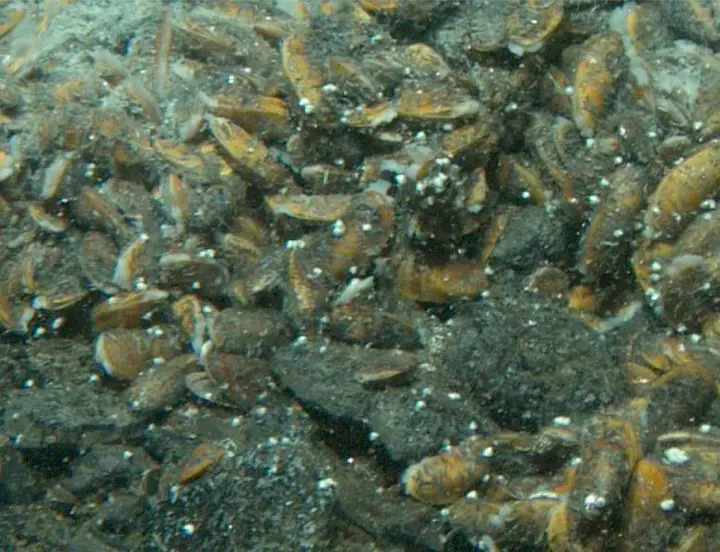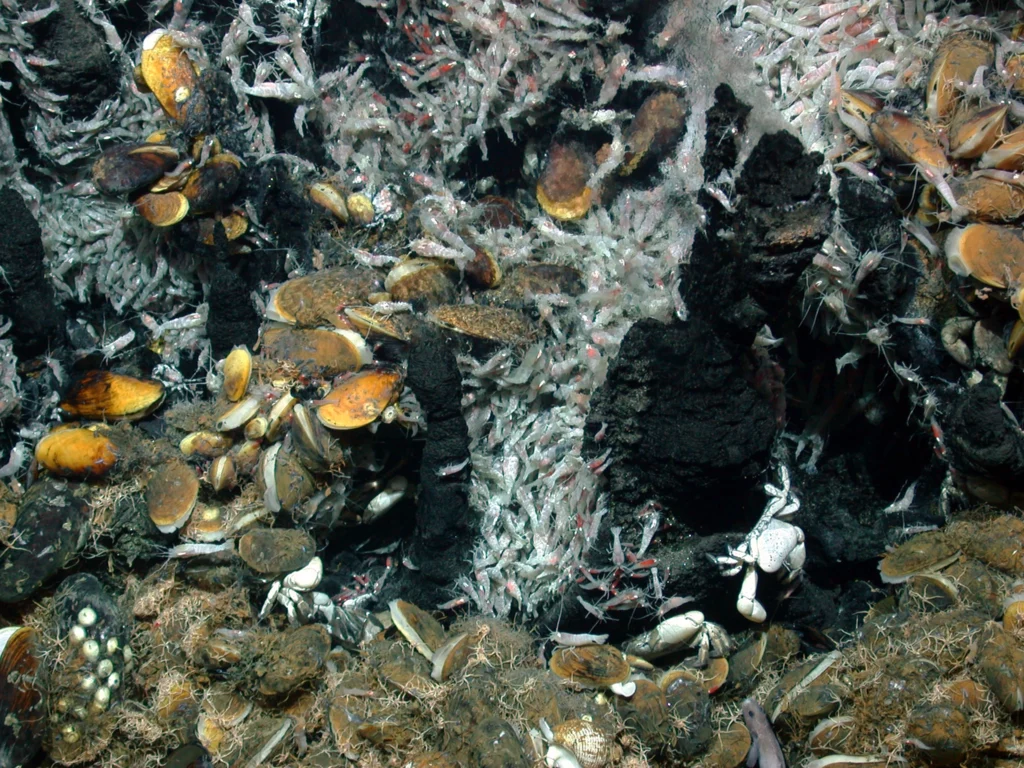Physical Address
304 North Cardinal St.
Dorchester Center, MA 02124

Deep within the ocean’s depths, where sunlight never penetrates, lies one of the most extreme and fascinating environments on Earth—hydrothermal vent ecosystems. These underwater hot springs, located along mid-ocean ridges and volcanic areas, are teeming with life despite the absence of sunlight. Hydrothermal vents are a window into the geological processes of our planet and a testament to life’s incredible adaptability. In this article, we’ll explore the mysteries of these vents, how they support diverse ecosystems, and their significance to both the ocean and our understanding of life itself.
Hydrothermal vents form where tectonic plates pull apart, allowing seawater to seep into the Earth’s crust. As this water descends, it encounters magma and becomes superheated, reaching temperatures up to 400°C (752°F). The superheated water, rich with dissolved minerals and chemicals like hydrogen sulfide, then shoots back up through fissures in the seafloor, creating towering chimneys known as “black smokers” and “white smokers,” depending on the mineral composition.
“Diagram of biogeochemical processes within a hydrothermal vent system (NOAA)”
These vents are found primarily along the global mid-ocean ridge system, which spans over 60,000 kilometers (37,282 miles). The deep-sea vents create a dynamic and ever-changing environment, with some vent fields being active for decades while others may last only a few years. The intense heat and chemical-rich plumes that hydrothermal vents emit offer a stark contrast to the frigid, pitch-black waters of the deep ocean.
Unlike most ecosystems on Earth that rely on sunlight and photosynthesis as the primary source of energy, hydrothermal vent ecosystems are powered by chemosynthesis. In this process, specialized bacteria and archaea convert chemicals such as hydrogen sulfide, methane, and ammonia into organic matter, providing a crucial energy source for life forms inhabiting these dark depths.
These chemosynthetic microbes form the base of the vent ecosystem’s food chain, sustaining a wide array of organisms. By converting toxic chemicals into nutrients, these bacteria create the foundation for life in one of Earth’s most hostile environments. This process not only supports the organisms directly associated with the vents but also influences the broader deep-sea ecosystem, with some species migrating between vent sites.
Hydrothermal vent ecosystems are home to a range of highly specialized organisms, many of which are not found anywhere else on Earth. These organisms have evolved remarkable adaptations to survive extreme conditions, such as high pressure, toxic chemicals, and fluctuating temperatures.

“From the 2011 NOAA Galapagos Rift Expedition.”
One of the most iconic creatures found at hydrothermal vents is the giant tube worm. These organisms can grow up to 2.4 meters (8 feet) long and thrive near the scalding plumes of vent chimneys. Unlike most animals, tube worms lack a digestive system; instead, they harbor chemosynthetic bacteria within their bodies. These bacteria convert hydrogen sulfide from the vent into energy, providing nutrients for the tube worm. This symbiotic relationship allows tube worms to flourish in an environment where few other organisms could survive.

Mussels and clams are also common inhabitants of hydrothermal vent communities. These bivalves have developed symbiotic relationships with chemosynthetic bacteria similar to those found in tube worms. They are capable of extracting chemicals from the vent fluids and utilizing them to produce nutrients. This adaptation allows them to anchor themselves in the high-pressure, mineral-rich environment and thrive.

A swarm of shrimp from the genus Alvinocaris (NOAA)
Hydrothermal vent shrimp are another unique resident of these ecosystems. These shrimp gather in large clusters near the vent chimneys, feeding on bacteria and organic particles. They have evolved specialized adaptations, such as sensory structures that detect chemical changes in the water rather than relying on vision, as light is absent in these depths. Their ability to locate vent sites and exploit the energy from chemosynthetic bacteria ensures their survival in these extreme habitats.
Hydrothermal vent ecosystems are crucial to understanding how life can exist under extreme conditions and may even provide insights into the origins of life on Earth. The discovery of these environments in the 1970s challenged the prevailing notion that sunlight was essential for sustaining life, revealing that energy sources other than the sun can support complex ecosystems.Moreover, hydrothermal vents play a significant role in the global ocean. They influence the chemistry of seawater, as the minerals and compounds emitted from the vents spread through the ocean. This process contributes to nutrient cycling, impacting marine life beyond the immediate vicinity of the vents.

Living community at hydrothermal seeps on the Mid-Ocean Ridge at a water depth of 3,030 m (9,940 ft)
The biodiversity of hydrothermal vents also holds scientific value. Many of the species found at these sites are endemic, meaning they are not found anywhere else in the world. Studying these organisms helps scientists better understand evolution, adaptation, and resilience, as well as how ecosystems develop in isolation.
The discovery of hydrothermal vent ecosystems has revolutionized the search for life beyond Earth. The ability of organisms to thrive in the absence of sunlight and in conditions once thought too extreme for life suggests that similar environments on other planets or moons could also harbor life. For example, Europa, one of Jupiter’s moons, and Enceladus, a moon of Saturn, are believed to have subsurface oceans with conditions similar to those around Earth’s hydrothermal vents.
Studying these deep-sea ecosystems provides a blueprint for understanding the potential for life elsewhere in the universe. The unique adaptations and metabolic processes observed at hydrothermal vents demonstrate that life is more versatile than previously imagined, broadening the scope of astrobiology and the types of environments where scientists might search for extraterrestrial organisms.
Despite their remote locations, hydrothermal vent ecosystems are not immune to human influence. Deep-sea mining, particularly for valuable minerals like copper, zinc, and rare earth elements, poses a significant threat to these fragile ecosystems. Mining activities can disrupt the delicate balance of vent habitats, leading to loss of biodiversity and the destruction of endemic species.To address these threats, marine biologists and environmental organizations advocate for the protection of hydrothermal vent sites. International agreements, such as those negotiated under the United Nations Convention on the Law of the Sea (UNCLOS), play a crucial role in establishing guidelines and marine protected areas (MPAs) to safeguard these unique ecosystems. The conservation of hydrothermal vents is not only about protecting biodiversity but also about preserving ecosystems that may hold vital information about Earth’s past and future.
Rogers et al. (2012) recognized at least 11 biogeographic provinces of hydrothermal vent systems:

“Distribution of hydrothermal vents“
Hydrothermal vent ecosystems are some of the most extraordinary and enigmatic environments on Earth. These deep-sea habitats reveal the incredible adaptability of life, showing that it can thrive even in the most extreme conditions. The discovery of hydrothermal vents has expanded our understanding of the ocean, the processes that sustain life, and the potential for life beyond Earth. As we continue to explore and study these ecosystems, protecting them from human impacts is essential to preserve their ecological and scientific value. Hydrothermal vents remind us of the vast mysteries the ocean still holds and the interconnectedness of Earth’s life-supporting systems.